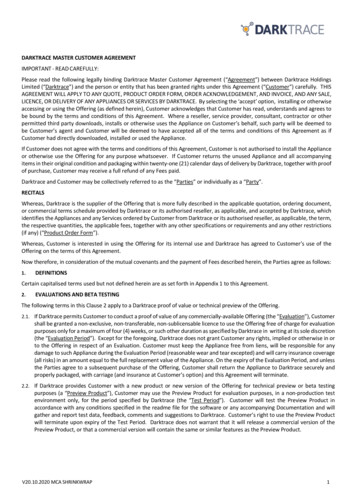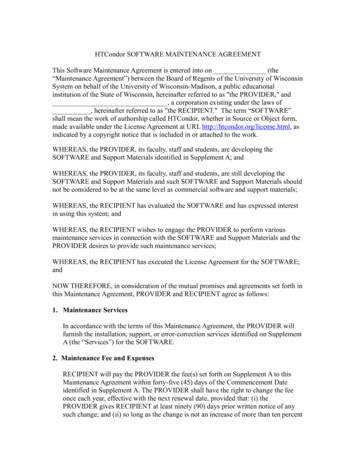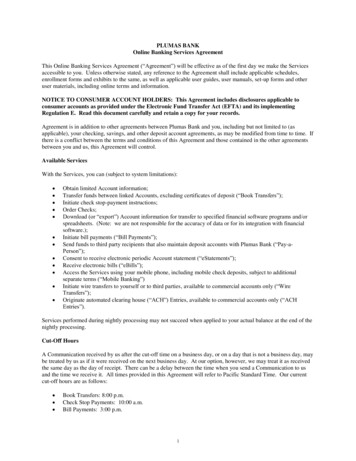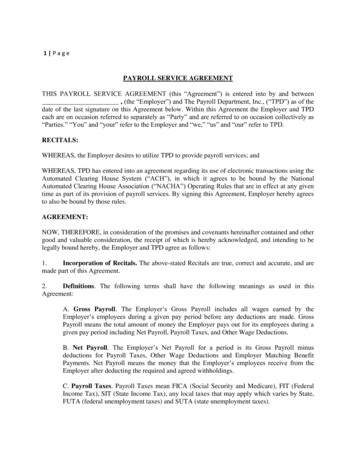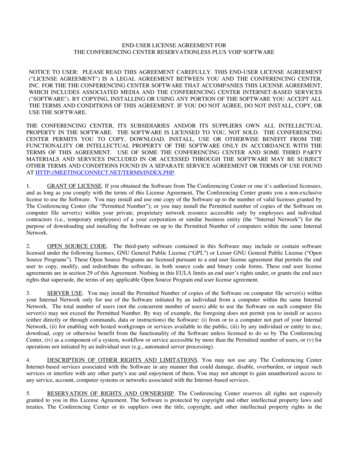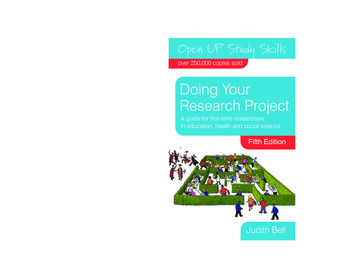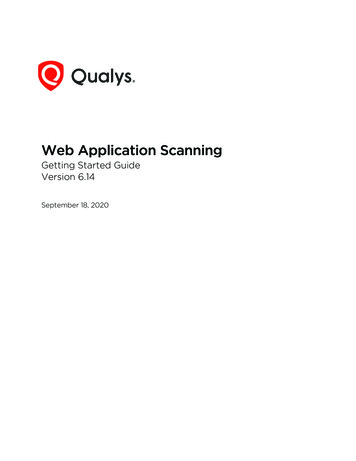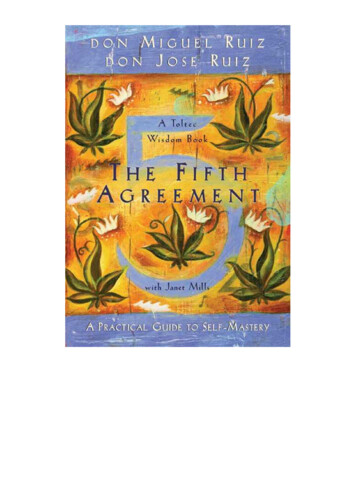
Transcription
THE FIFTHAGREEMENTMIGUEL RUIZDON J OSE R UIZWITH J ANET MILLSDONAMBER-ALLEN PUBLISHINGSAN RAFAEL, CALIFORNIA
AcknowledgmentsTHE AUTHORS WISH TO EXPRESS THEIR HEARTFELT gratitude to the following people:Janet Mills, the mother of this book; Judy Segal, for all her love and support; Ray Chambers, forlighting the way; Oprah Winfrey and Ellen DeGeneres, for sharing the message of The FourAgreements with so many people; Ed Rosenberg and Major General Riemer, for their recognitionof The Four Agreements on the United States Air Force challenge coin; Gail Mills, Karen Kreiger,and Nancy Carleton, for generously contributing their time and talent to the realization of thisbook; and Joyce Mills, Maiya Champa, Dave McCullough, Theresa Nelson, and Shkiba SamimiAmri for their dedication and ongoing support of the teachings of the Toltec.
The ToltecTHOUSANDS OF YEARS AGO, THE TOLTEC WERE known throughout southern Mexico as“women and men of knowledge.” Anthropologists have spoken of the Toltec as a nation or a race,but, in fact, the Toltec were scientists and artists who formed a society to explore and conservethe spiritual knowledge and practices of the ancient ones. They came together as masters(naguals) and students at Teotihuacan, the ancient city of pyramids outside Mexico City known asthe place where “Man Becomes God.” Over the millennia, the naguals were forced to conceal theancestral wisdom and maintain its existence in obscurity. European conquest, coupled withrampant misuse of personal power by a few of the apprentices, made it necessary to shield theknowledge from those who were not prepared to use it wisely or who might intentionally misuse itfor personal gain.Fortunately, the esoteric Toltec knowledge was embodied and passed on through generationsby different lineages of naguals. Though it remained veiled in secrecy for hundreds of years,ancient prophecies foretold the coming of an age when it would be necessary to return thewisdom to the people. Now, don Miguel Ruiz and don Jose Ruiz (naguals from the Eagle Knightlineage) have been guided to share with us the powerful teachings of the Toltec.Toltec wisdom arises from the same essential unity of truth as all the sacred esoteric traditionsfound around the world. Though it is not a religion, it honors all the spiritual masters who havetaught on the earth. While it does embrace spirit, it is most accurately described as a way of life,distinguished by the ready accessibility of happiness and love.
Introductionby don Miguel RuizTHE FOUR AGREEMENTS WAS PUBLISHED MANY YEARS ago. If you have read the book,you already know what these agreements can do. They have the ability to transform your life bybreaking thousands of limiting agreements you have made with yourself, with other people, withlife itself.The first time you read The Four Agreements, it begins to work its magic. It goes much deeperthan the words you are reading. You feel that you already know every word in the book. You feelit, but perhaps you never put it into words. When you read the book the first time, it challengeswhat you believe, and takes you to the limit of your comprehension. You break many limitingagreements, and overcome many challenges, but then you see new challenges. When you readthe book a second time, it feels as if you’re reading a completely different book because the limitsof your comprehension have already grown. Once again, it takes you into a deeper awareness ofyourself, and you reach the limit that you can reach in that moment. And when you read the booka third time, it’s just as if you’re reading another book.Just like magic, because they are magic, the Four Agreements slowly help you to recover yourauthentic self. With practice, these four simple agreements take you to what you really are, notwhat you pretend to be, and this is exactly where you want to be: what you really are.The principles in The Four Agreements speak to the heart of all human beings, from the youngto the old. They speak to people of different cultures all around the world — people who speakdifferent languages, people whose religious and philosophical beliefs are vastly different. Theyhave been taught at different kinds of schools, from elementary schools to secondary schools touniversities. The principles in The Four Agreements reach everyone because they are purecommon sense.Now it’s time to give another gift: The Fifth Agreement. The fifth agreement wasn’t included inmy first book because the first four agreements were enough of a challenge at that time. The fifthagreement is made with words, of course, but its meaning and intent is beyond the words. Thefifth agreement is ultimately about seeing your whole reality with the eyes of truth, without words.The result of practicing the fifth agreement is the complete acceptance of yourself just the way youare, and the complete acceptance of everybody else just the way they are. The reward is youreternal happiness.Many years ago, I began teaching some of the concepts in this book to my apprentices, but thenI stopped because nobody seemed to understand what I was trying to say. Though I had sharedthe fifth agreement with my apprentices, I discovered that nobody was ready to learn theteachings that underlie this agreement. Years later, my son, don Jose, started to share the sameteachings with a group of students, and he succeeded where I had failed. Maybe the reason donJose was successful was because he had complete faith in sharing the message. His verypresence spoke the truth and challenged the beliefs of the people who attended his classes. Hemade a huge difference in their lives.Don Jose Ruiz has been my apprentice since he was a child, since he learned to speak. In thisbook, I am honored to introduce my son, and to present the essence of the teachings we deliveredtogether over a period of seven years.To keep the message as personal as possible, and in keeping with the first-person voice ofprior books in the Toltec Wisdom series, we have opted to present The Fifth Agreement in thesame first-person style of writing. In this book, we speak to the reader with one voice, and withone heart.
IN THE BEGINNINGIt’s All in the ProgramFROM THE MOMENT YOU ARE BORN, YOU DELIVER a message to the world. What is themessage? The message is you, that child. It’s the presence of an angel, a messenger from theinfinite in a human body. The infinite, a total power, creates a program just for you, and everythingyou need to be what you are is in the program. You are born, you grow up, you mate, you growold, and in the end you return to the infinite. Every cell in your body is a universe of its own. It’sintelligent, it’s complete, and it’s programmed to be whatever it is.You are programmed to be you, whatever you are, and it makes no difference to the programwhat your mind thinks you are. The program is not in the thinking mind. It’s in the body, in what wecall the DNA, and in the beginning, you instinctively follow its wisdom. As a very young child, youknow what you like, what you don’t like, when you like it, when you don’t. You follow what youlike, and you try to avoid what you don’t like. You follow your instincts, and those instincts guideyou to be happy, to enjoy life, to play, to love, to fulfill your needs. Then what happens?Your body begins to develop, your mind begins to mature, and you begin to use symbols todeliver your message. Just as the birds understand the birds, and the cats understand the cats,the humans understand the humans through a symbology. If you were born on an island and thenlived all alone, it might take you ten years, but you would give a name to everything that you see,and you would use that language to communicate a message, even if it was only to yourself. Whywould you do this? Well, it’s easy to understand, and it’s not because humans are so intelligent.It’s because we are programmed to create a language, to invent an entire symbology forourselves.As you know, all around the world humans speak and write in thousands of different languages.Humans have invented all kinds of symbols to communicate not only with other humans but moreimportantly with ourselves. The symbols can be sounds that we speak, motions that we make, orhandwriting and signs that are graphic in nature. There are symbols for objects, ideas, music, andmathematics, but the introduction of sounds is the very first step, which means we learn to usesymbols to speak.The humans who come before us already have names for everything that exists, and they teachus the meaning of sounds. They call this a table; they call that a chair. They also have names forthings that only exist in our imagination, like mermaids and unicorns. Every word that we learn isa symbol for something real or imagined, and there are thousands of words to learn. If we observechildren who are one to four years old, we can see the effort they make trying to learn an entiresymbology. It’s a big effort that we usually don’t remember because our mind is not yet mature,but with repetition and practice we finally learn to speak.Once we learn to speak, the humans who take care of us teach us what they know, whichmeans they program us with knowledge. The humans we live with have lots of knowledge,including all the social, religious, and moral rules of their culture. They hook our attention, pass onthe information, and teach us to be like them. We learn how to be a man or a woman according tothe society in which we are born. We learn how to behave the “right” way in our society, whichmeans how to be a “good” human.In truth, we are domesticated the same way that a dog, a cat, or any animal is domesticated:through a system of punishment and reward. We are told that we’re a good boy or a good girlwhen we do what the grown-ups want us to do; we’re a bad boy or a bad girl when we don’t dowhat they want us to do. Sometimes we are punished without being bad, and sometimes we arerewarded without being good. Out of fear of being punished and fear of not getting a reward, westart trying to please other people. We try to be good, because bad people don’t receive rewards;they are punished.In human domestication, all the rules and values of our family and society are imposed on us.We don’t have the opportunity to choose our beliefs; we are told what to believe, and what not tobelieve. The people we live with tell us their opinions: what is good and what is bad, what is rightand what is wrong, what is beautiful and what is ugly. Just like a computer, all that information is
downloaded into our head. We are innocent; we believe what our parents or other grown-ups tellus; we agree, and the information is stored in our memory. Everything we learn goes into our mindby agreement, and it stays in our mind by agreement, but first it goes through the attention.The attention is very important in humans because it’s the part of the mind that makes itpossible for us to concentrate on a single object or thought out of a whole range of possibilities.Through the attention, information from the outside is conveyed to the inside and vice versa. Theattention is the channel we use to send and receive messages from human to human. It’s like abridge from one mind to another mind; we open the bridge with sounds, signs, symbols, touch —with any event that hooks the attention. This is how we teach, and this is how we learn. Wecannot teach anything if we don’t have someone’s attention; we cannot learn anything if we don’tpay attention.Using the attention, the grown-ups teach us how to create an entire reality in our mind with theuse of symbols. After they teach us a symbology by sound, the grown-ups drill us with our ABCs,and we learn the same language, but graphically. Our imagination begins to develop, ourcuriosity grows stronger, and we start to ask questions. We ask and ask, and we keep askingquestions; we gather information from everywhere. And we know that we’ve finally mastered alanguage when we are able to use the symbols to talk to ourselves in our head. This is when welearn to think. Before that, we don’t think; we mimic sounds and use symbols to communicate, butlife is simple before we attach any meaning or emotion to the symbols.Once we give meaning to the symbols, we begin to use them to try to make sense of everythingthat happens in our lives. We use the symbols to think about things that are real, and to thinkabout things that aren’t real, but that we start to imagine are real, like beautiful and ugly, skinnyand fat, smart and stupid. And if you notice, we can only think in a language that we master. Formany years, I spoke only Spanish, and it took a long time for me to master enough symbols inEnglish to think in English. To master a language is not easy, but at a certain point, we findourselves thinking with the symbols we learn.By the time we go to school, when we are five or six years old, we understand the meaning ofabstract concepts like right and wrong, winner and loser, perfect and imperfect. In school, wecontinue to learn how to read and write the symbols we already know, and the written languagemakes it possible for us to accumulate more knowledge. We continue to give meaning to moreand more symbols, and thinking becomes not only effortless but automatic.Now the symbols that we learned are hooking our attention all by themselves. It’s what weknow that’s talking to us, and we are listening to what our knowledge says. I call it the voice ofknowledge because knowledge is talking in our head. Many times we hear the voice with differenttonalities; we hear the voice of our mother, our father, our brothers and sisters, and the voicenever stops talking. The voice isn’t real; it’s our creation. But we believe that it’s real because wegive it life through the power of our faith, which means we believe without a doubt what that voiceis telling us. This is when the opinions of the humans around us start taking over our mind.Everybody has an opinion of us, and they tell us what we are. As very young children, we don’tknow what we are. The only way we can see ourselves is through a mirror, and other people actas that mirror. Our mother tells us what we are, and we believe her. It’s completely different fromwhat our father tells us, or what our brothers and sisters tell us, but we agree with them, too.People tell us how we look, and it’s especially true when we are little children. “Look, you havethe eyes of your mother, the nose of your grandfather.” We listen to all the opinions of our family,our teachers, and the big children at school. We see our image in those mirrors, we agree that thisis what we are, and as soon as we agree, that opinion becomes a part of our belief system. Littleby little, all these opinions modify our behavior, and in our mind we form an image of ourselvesaccording to what other people say we are: “I’m beautiful; I’m not so beautiful. I’m smart; I’m not sosmart. I’m a winner; I’m a loser. I’m good at this; I’m bad at that.”At a certain point, all the opinions of our parents and teachers, religion and society, make usbelieve that we need to be a certain way in order to be accepted. They tell us the way we shouldbe, the way we should look, the way we should behave. We need to be this way; we shouldn’t bethat way — and because it’s not okay for us to be what we are, we start pretending to be what weare not. The fear of being rejected becomes the fear of not being good enough, and we startsearching for something that we call perfection. In our search, we form an image of perfection, theway we wish to be, but we know that we are not, and we begin to judge ourselves for that. We
don’t like ourselves, and we tell ourselves, “Look how silly you look, how ugly you are. Look howfat, how short, how weak, how stupid you are.” This is when the drama begins, because now thesymbols are going against us. We don’t even notice that we’ve learned to use the symbols toreject ourselves.Before domestication, we don’t care what we are or what we look like. Our tendency is toexplore, to express our creativity, to seek pleasure and avoid pain. As little children, we are wildand free; we run around naked without self-consciousness or selfjudgment. We speak the truthbecause we live in truth. Our attention is in the moment; we are not afraid of the future or ashamedof the past. After domestication, we try to be good enough for everybody else, but we are nolonger good enough for ourselves, because we can never live up to our image of perfection.All of our normal human tendencies are lost in the process of domestication, and we begin tosearch for what we have lost. We start searching for freedom because we are no longer free to bewhat we really are; we start searching for happiness because we are no longer happy; we startsearching for beauty because we no longer believe that we are beautiful.We continue to grow, and in our adolescence, our body is programmed to introduce asubstance we call hormones. Our physical body is no longer a child’s, and we don’t fit in with theway of life we lived before. We don’t want to hear our parents tell us what to do and what not todo. We want our freedom; we want to be ourselves, but we are also afraid to be by ourselves.People tell us, “You’re not a child anymore,” but we’re not an adult either, and it’s a difficult timefor most humans. By the time we are teenagers, we don’t need anyone to domesticate us; wehave learned to judge ourselves, punish ourselves, and reward ourselves according to the samebelief system we were given, and using the same system of punishment and reward. Thedomestication may be easier for people in some places in the world, and harder for people inother places, but in general none of us has a chance of escaping the domestication. None of us.Finally, the body matures and everything changes again. We start searching once again, butnow, more and more, what we are searching for is our self. We are searching for love because wehave learned to believe that love is somewhere outside of us; we are searching for justicebecause there is no justice in the belief system we were taught; we are searching for truthbecause we only believe in the knowledge we have stored in our mind. And of course, we’re stillsearching for perfection because now we agree with the rest of the humans that “nobody’sperfect.”
SYMBOLS AND AGREEMENTSThe Art of HumansDURING ALL THE YEARS THAT WE GROW UP, WE MAKE countless agreements withourselves, with society, with everybody around us. But the most important agreements are theones we make with ourselves by understanding the symbols we learned. The symbols are tellingus what we believe about ourselves; they’re telling us what we are and what we are not, what ispossible and what is not possible. The voice of knowledge is telling us everything that we know,but who tells us if what we know is the truth?When we go to grammar school, high school, and college, we acquire a lot of knowledge, butwhat do we really know? Do we master the truth? No, we master a language, a symbology, andthat symbology is only the truth because we agree, not because it’s really the truth. Wherever weare born, whatever language we learn to speak, we find that almost everything we know is reallyabout agreements, beginning with the symbols that we learn.If we are born in England, we learn English symbols. If we are born in China, we learn Chinesesymbols. But whether we learn English, Chinese, Spanish, German, Russian, or any otherlanguage, the symbols only have value because we assign them a value and agree on theirmeaning. If we don’t agree, the symbols are meaningless. The word tree, for example, ismeaningful for people who speak English, but “tree” doesn’t mean anything unless we believethat it means something, unless we agree. What it means for you, it means for me, and that’s whywe understand one another. What I’m saying right now you understand because we agree withthe meaning of every word that was programmed in our mind. But this doesn’t mean that wecompletely agree. Each of us gives a meaning to every word, and it’s not exactly the same foreveryone.If we focus our attention on the way any word is created, we find that whatever meaning wegive to a word is there for no real reason. We put words together from nowhere; we make them up.Humans invent every sound, every letter, every graphic symbol. We hear a sound like “A” and wesay, “This is the symbol for that sound.” We draw a symbol to represent the sound, we put thesymbol and the sound together, and we give it a meaning. Then every word in our mind has ameaning, but not because it’s real, not because it’s truth. It’s just an agreement with ourselves,and with everybody else who learns the same symbology.If we travel to a country where people speak a different language, we suddenly realize theimportance and power of agreement. Un árbol es sólo un árbol, el sol es sólo el sol, la tierra essólo la tierra si estamos de acuerdo.,,,. Ein Baum ist nur ein Baum, die Sonne ist nur die Sonne, dieErde ist nur die Erde wenn wir uns darauf verständigt haben.,,,. A tree is only a tree, the sun is only the sun, the earth is only theearth if we agree. These symbols have no meaning in France, Russia, Turkey, Sweden, or in anyother place where the agreements are different.If we learn to speak English and we go to China, we hear people talking, but we don’tunderstand a word they are saying. Nothing makes sense to us because it’s not the symbologythat we learned. Many things are foreign to us; it’s like being in another world. If we visit theirplaces of worship, we find that their beliefs are completely different, their rituals are completelydifferent, their mythologies have nothing to do with what we learned. One way to understand theirculture is to learn the symbols they use, which means their language, but if we learn a new way ofbeing, a new religion or philosophy, this may create a conflict with what we learned before. Newbeliefs clash with old beliefs, and the doubt comes right away: “What is right and what is wrong?Is it true what I learned before? Is it true what I’m learning right now? What is the truth?”The truth is that all of our knowledge, 100 percent of it, is nothing more than symbolism orwords that we invent for the need to understand and express what we perceive. Every word in ourmind and on this page is just a symbol, but every word has the power of our faith because webelieve in its meaning without a doubt. Humans construct an entire belief system made up ofsymbols; we build an entire edifice of knowledge. Then we use everything we know, which is
nothing but symbology, to justify what we believe, to try to explain first to ourselves, then toeverybody around us, the way we perceive ourselves, the way we perceive the entire universe.If we are aware of this, then it’s easy to understand that all of the different mythologies,religions, and philosophies around the world, all of the different beliefs and ways of thinking, arenothing but agreements with ourselves and with other humans. They’re our creation, but are theytrue? Everything that exists is true: the earth is true, the stars are true, the entire universe hasalways been true. But the symbols that we use to construct what we know are only true becausewe say so.There’s a beautiful story in the Bible that illustrates the relationship between God and humans. Inthis story, Adam and God are walking together around the world, and God asks Adam what hewants to name everything. One by one, Adam gives a name to everything he perceives. “Let’s callthis a tree. Let’s call this a bird. Let’s call this a flower .” And God agrees with Adam. The story isabout the creation of symbols, the creation of an entire language, and it works by agreement.It’s like two sides of the same coin: We can say that one side is pure perception, what Adamperceives; the other side is the meaning that Adam gives to whatever he perceives. There’s theobject of perception, which is the truth, and there’s our interpretation of the truth, which is just apoint of view. The truth is objective, and we call it science. Our interpretation of the truth issubjective, and we call it art. Science and art; the truth, and our interpretation of the truth. The realtruth is life’s creation, and it’s the absolute truth because it’s truth for everyone. Our interpretationof the truth is our creation, and it’s a relative truth because it’s only truth by agreement. With thisawareness, we can begin to understand the human mind.All humans are programmed to perceive the truth, and we don’t need a language to do this. Butin order to express the truth, we need to use a language, and that expression is our art. It’s nolonger the truth because words are symbols, and symbols can only represent or “symbolize” thetruth. For example, we can see a tree even if we don’t know the symbol “tree.” Without the symbol,we just see an object. The object is real, it is truth, and we perceive it. Once we call it a tree, weare using art to express a point of view. By using more symbols, we can describe the tree — everyleaf, every color. We can say it’s a big tree, a small tree, a beautiful tree, an ugly tree, but is it thetruth? No, the tree is still the same tree.Our interpretation of the tree will depend on our emotional reaction to the tree, and ouremotional reaction will depend on the symbols that we use to recreate the tree in our mind. Asyou can see, our interpretation of the tree is not exactly the truth. But our interpretation is areflection of the truth, and that reflection is what we call the human mind. The human mind isnothing but a virtual reality. It isn’t real. What’s real is truth. What’s truth is truth for everyone. Butthe virtual reality is our personal creation; it’s our art, and it’s only “truth” for each one of us.All humans are artists, all of us. Every symbol, every word, is a little piece of art. From my pointof view, and thanks to our programming, our greatest masterpiece of art is the use of a languageto create an entire virtual reality within our mind. The virtual reality we create could be a clearreflection of the truth, or it could be completely distorted. Either way, it’s art. Our creation could beour personal heaven, or it could be our personal hell. It doesn’t matter; it’s art. But what we can dowith the awareness of what is truth and what is virtual is endless. The truth leads to self-mastery,to a life that’s very easy; our distortion of the truth often leads to needless conflict and humansuffering. Awareness makes all the difference.Humans are born with awareness; we are born to perceive the truth, but we accumulateknowledge, and we learn to deny what we perceive. We practice not being aware, and we masternot being aware. The word is pure magic, and we learn to use our magic against ourselves,against creation, against our own kind. To be aware means to open our eyes to see the truth.When we see the truth, we see everything just as it is, not the way we believe it is, not the way wewish it to be. Awareness opens the door to millions of possibilities, and if we know that we are theartist of our own life, we can make a choice from all those possibilities.What I’m sharing with you comes from my personal training, which I call Toltec Wisdom. Toltecis a Náhuatl word meaning artist. From my point of view, to be a Toltec has nothing to do with anyphilosophy or place in the world. To be a Toltec is just to be an artist. A Toltec is an artist of thespirit, and as artists we like beauty; we don’t like what is not beauty. If we become better artists,
our virtual reality becomes a better reflection of the truth, and we can create a masterpiece ofheaven with our art.Thousands of years ago, the Toltec created three masteries of the artist: the mastery ofawareness, the mastery of transformation, and the mastery of love, intent, or faith. The separationis just for our understanding, because the three masteries become only one. The truth is only one,and the truth is what we are talking about. These three masteries guide us out of suffering andreturn us to our true nature, which is happiness, freedom, and love.The Toltec understood that we are going to create a virtual reality with or without awareness. Ifit’s with awareness, we’re going to enjoy our creation. And whether we facilitate thetransformation or resist it, our virtual reality is always transforming. If we practice the art oftransformation, soon we’re facilitating the transformation, and instead of using our magic againstourselves, we are using our magic for the expression of our happiness and our love. When wemaster love, intent, or faith, we master the dream of our life, and when all three masteries areaccomplished, we reclaim our divinity and become one with God. This is the goal of the Toltec.The Toltec didn’t have the technology that we have at the present time; they didn’t know aboutthe virtual reality of computers, but they knew how to master the virtual reality of the human mind.The mastery of the human mind requires complete control of the attention — the way we interpretand react to information we perceive from inside of us and outside of us. The Toltec understoodthat each one of us is just like God, but instead of creating, we re-create. And what do we recreate? What we perceive. That is what becomes the human mind.If we can understand what the human mind is, and what the human mind does, we can begin toseparate reality from virtual reality, or pure perception, which is truth, from symbology, which is art.Self-mastery is all about awareness, and it begins with self-awareness. First to be aware of whatis real, and then to be aware of what is virtual, which means what we believe about what is real.With this awareness, we know that we can change what is virtual by changing what we believe.What is real we cannot change, and it doesn’t matter what we believe.
THE STORY OF YOUThe First
THE FOUR AGREEMENTS WAS PUBLISHED MANY YEARS ago. If you have read the book, you already know what these agreements can do. They have the ability to transform your life by breaking thousands of limiting agreements you have made with yourself, with other people, with life itself. The first tim

